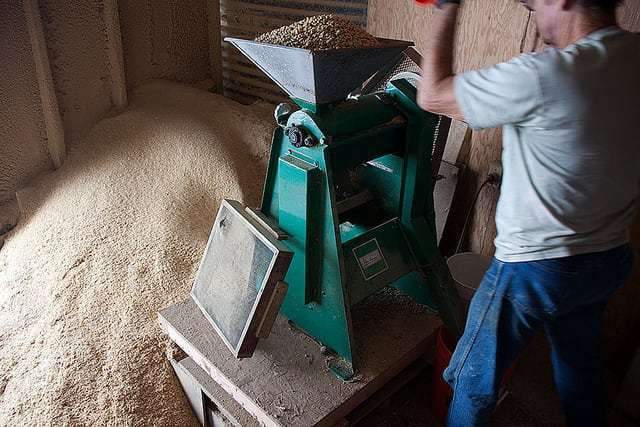The number one question we get asked is how we became coffee farmers in Hawaii, and what kind of experience we had before diving in. While we’ve described parts of our story before, this post will be different. These are the details it took for us to get where we are now.
And if you’re reading this because you too would someday like to farm coffee in Hawaii or anything else for that matter, we’ll provide 6 tips for beginning your journey of farming in Hawaii.
We moved from Portland, Oregon to Mountain View, Hawaii in September of 2010. At the time, we were looking to buy a house in Portland or possibly land to start a farm in the Willamette Valley. When a Craigslist real estate hunt led us to a listing for a small three-acre, vertically integrated coffee farm and wholesale floral business in Hawaii, we thought, “This has to be a scam.” The property included a barn, warehouse, home, small floral business, a fruit orchard, and 1500 coffee trees on 3 acres -- all for $298,000, owner-financed. Plus, one month of training in the floral business. As you’d expect, we immediately called the real estate agent, then Big Island to see it in person.
Now I know what you’re thinking: “All that for was included? You two got lucky!” Well, yes and no. There are great opportunities to farm throughout the Big Island - some more hidden than others. But we’ll come back to this point later.
We’d never heard of Puna nor Puna coffee, but it seemed like a natural fit for our interests and skillsets. We’re both nerds at heart; obsessive-compulsive enough to want do everything. It was perfect. The coffee trees were in horrible shape, but at the time we didn’t know it. The 24,000-gallon water tank was a firm earthquake away from sending a tidal wave through the bedroom, but we didn't know that either. We couldn’t see it through the dream, and our naïveté was a blessing.
At 74 years young, the prior owner, Bob (above), was eager to retire. The sale proceeded quickly, and within five months of viewing the property we’d moved in. Bob taught us to buy and sell Hawaii-grown flowers, which ensured us enough monthly income to pay the mortgage but not much else. And when Bob left, he left 30 years of stuff behind bins of old tools, piles of rusted sheet metal, 13 office chairs, 500 pounds of old coffee, his tiny decrepit old dog, dressers full of clothes and photo albums, and more. (We're still moving Bob out...)
We dove in headfirst, arriving at the start of the coffee harvest season in 2010 with absolutely no idea what the hell we were doing and a house full of junk that wasn’t ours. Neither of us had experience growing, processing, roasting or cupping coffee. We also had zero experience operating a business and managing a farm. Accounting, marketing, web development, design, packaging, animal husbandry, equipment maintenance, and repairs -- we had to learn and begin addressing all of these elements.
Care-taking a business, farm, and animals demands great responsibility. Coffee was only a fraction of the life we had to learn to live.
Those first few years were an exhaustive adventure. We grew the majority of our food and used old pulping equipment glued together with roofing gutter (below) to process coffee cherry for neighboring farms. We learned to butcher sheep and wild boar and began trading the “practice” coffees with neighboring farmers for palm heart, greens & fish. At one point we shipped 400 day-old chicks from Iowa to our farm in Puna and resold them locally for a profit. All while trying to understand coffee, from farm to cup. Gotta do what you gotta do, right?
It was like going to college without professors and the “test” was to make an income, good coffee, and not injure ourselves in the process. We learned quickly and voraciously. The flowers were our "bread and butter" but the coffee kept us excited. With it, we’d experiment, test extremes, learn limitations, respect parameters, make mistakes, and repeat. Tasting everything (we still do).
In 2013, after three years of training our palate to the variations in coffee and learning to farm, process and roast, we quit the flower business, registered Big Island Coffee Roasters and began submitting our coffees to reviewers. With what we learned, we began working with farmers one-on-one, roasting their coffees, and purchasing from other regions.
It was a total surprise when, in July of 2013, our Puna Pink Bourbon coffee won Grand Champion in the Hawaii Coffee Association’s Statewide Cupping Competition and became the first non-Kona or Ka’u farm to do so. The same year, the USDA honored our efforts to improve East Hawaii’s coffee quality by awarding us a grant to purchase East Hawaii’s first coffee grading equipment, enabling us to help other coffee farmers add value to their crop. And as the year closed, our Honeyed Yellow Caturra was awarded a 94-point score and placed #19 in Coffee Review’s “Top 30 Coffees of 2013”. That year we sold out of our “unheard of” coffee.
The next year we were elected to serve on the Board of Directors for the Hawaii Coffee Association – Hawaii’s largest coffee organization - to represent East Hawaii coffee farmers.
Today we're fully immersed in farm-to-cup coffee every day of the week, and growing into cacao. We continue to serve on the Board of Directors for the Hawaii Coffee Association, write the industry newsletters, and travel to trade shows for the organization. (Many of the blogs published on our website are inspired by heated debates within the local industry.) We work with 19 regional coffee farmers, processing, roasting, cupping, and consulting as needed. And we’ve got big plans for this year… but we'll save that for another post.
Six Tips For Farming in Hawaii
If you’d someday like to farm coffee in Hawaii or anything else for that matter, here are 6 useful tips for farming in Hawaii:
1. Have a good savings or a remote job you can rely initially. No matter where you are or what you're farming, you’ll probably need more money. Here’s a good rule of thumb we heard from a wise farmer named Mary Ryan, and it’s held true for us: “When estimating the net income for your farm, take your expected expenses and double them, then take your expected profit, and cut it in half. And if you're still in the black, proceed.”
2. Figure out what your “unfair advantage” is, and use it. In a state where the average farmer age is 59, our unfair advantage is our ability to use social media & technology effectively. So we rely less on cold-calling and farmers markets than we used to. We also rely less on local rumor and more on research when making decisions. What’s your “unfair advantage”?
3. This is a big tip, so pay attention. If you’re scraping to assemble your dream of living and/or farming in Hawaii, be willing to live (almost) anywhere in the beginning. There’s affordable housing available throughout Puna, but it’s not always glamorous. Search for properties near Pahoa, Hawaii Paradise Park, Kapoho, Kurtistown, Mountain View, and Glenwood.
4. If you can’t buy an existing farm, try starting one from scratch. Raw agricultural land in Hamakua runs $200/acre/year. There are also lease properties available in Shipman Park.
5. The State of Hawaii has more money available for farmers than farmers have time to apply for the grants. But if you can write convincingly well, and you’re looking for a farmer to teach you the trade, it’s feasible that you could partner with a farmer and help them apply for a grant in exchange for, perhaps, training and lodging. It's a win-win situation for both parties. Getting hands-on experience will save you time in the long run, and this kind of work-exchange has long-term value for both parties.
6. This tip ties in with the last. Find a farmer willing to teach & house you in exchange for work. However, keep in mind that many farms are moving away from work-exchange labor because exchange workers are can be unreliable, transient, and the work quality is typically lower than local paid labor. Try offering to help with something you're already good at for a pre-determined period. We've noticed plenty of Hawaii farmers that could use help with marketing and outreach, like writing newsletters, social media, and going to farmers markets, in addition to general labor.
In any case, if you do find an exchange farm, overdeliver.You’ll be invited to stay!
Resources:
The Kohala Center
Hamakua Ag Coop
Shipman Lease Property
WWOOF Hawaii
We'd enjoy hearing your thoughts. Please send them to Hello@BigIslandCoffeeRoasters.com.




